Reviewer's Note: This is a new review of the ITP C7 1AA continuously-variable light - both the Regular and Tactical versions. Previously, I had posted a pre-review of the 1AA/2AA battery tubes on the pre-production Regular head - that thread has been replaced by this review and a full review of the ITP C8 2AA Regular and Tactical lights. Note that a lot of the background text is similar between this review and the C7 review. A sales thread for the C7/C8 lights is available in CPFM. The lights were provided by ITP for review.
Warning: Pic heavy!
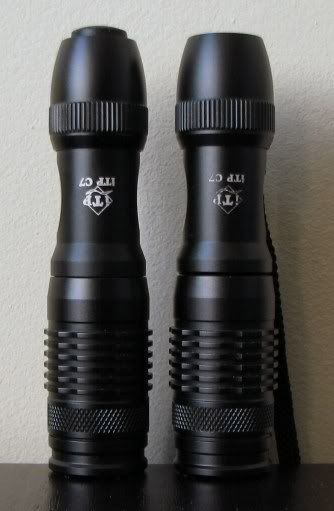
The C7 is part of a series of new continuously-variable lights from ITP. The lights come with either a Tactical or Regular head that is interchangeable on three different battery/body tube configurations: 1xAA/14500 (C7), 2xAA (C8), and 1xCR123A/RCR (C9). The pre-production C9 Regular model was reviewed previously, and the shipping C8 Regular and Tactical versions have just been reviewed as well.
Note that ITP has made individual body tubes/tailcaps available for sale, so you can mix-and-match components for different battery configurations with your preferred head unit (the Tactical and Regular versions differ slightly in circuit programming in the head).
For those of you not familiar with ITP lights, they have one of the most intuitive and easy-to-use continuously-variable systems I've seen to date. Scroll down for a discussion of the user interface.
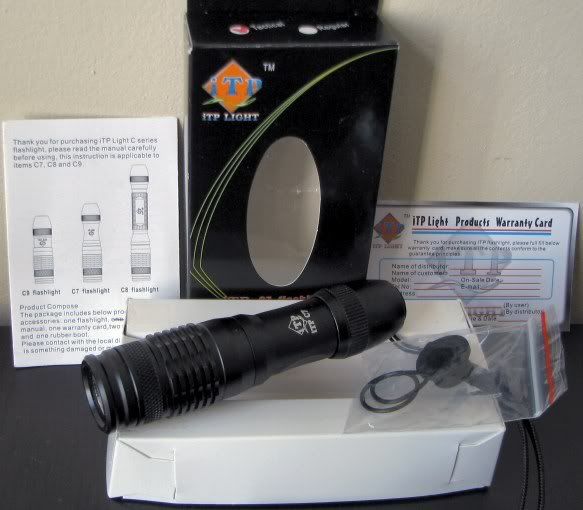
The shipping versions of the C7s come in a standard cardboard box (identified as Tactical or Regular on the top). Included inside are the light, an attached wrist strap, instruction manual, warranty card, and a package of spare o-rings and an extra tailcap switch cover.
C7 Weight: 76.2 g
C7 Length: 107 mm (Regular), 110 mm (Tactical)
C7 Width: 27 mm max (at heatsink fins on the head)
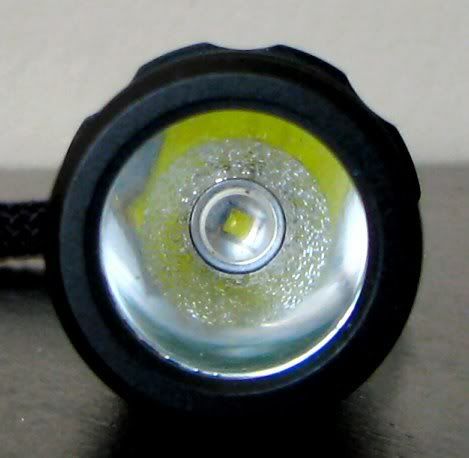
Note the aluminum reflector - it's half textured and half smooth, similar to early Olights. oo: In fact, it appears to be identical to the one used by Olight (i.e. same dimensions). This pattern is done to help smooth out the Cree rings around the hotspot, while maintaining decent throw.
oo: In fact, it appears to be identical to the one used by Olight (i.e. same dimensions). This pattern is done to help smooth out the Cree rings around the hotspot, while maintaining decent throw.
Here are some pics of the Regular version, with the pre-production C7 body and tailcap:
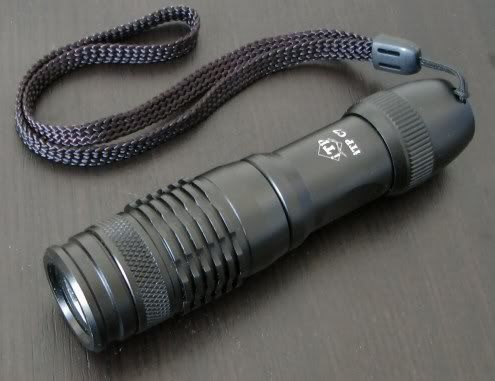
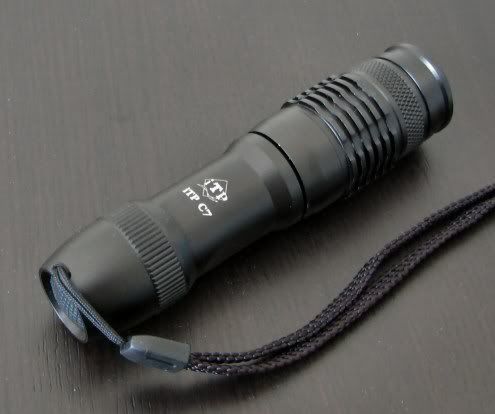
And here is the new Tactical version with the shipping C7 body and tailcap:
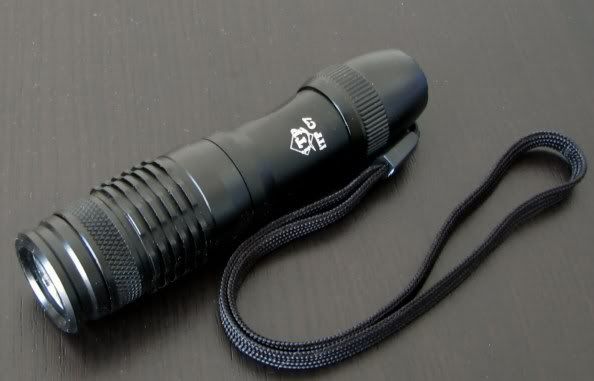
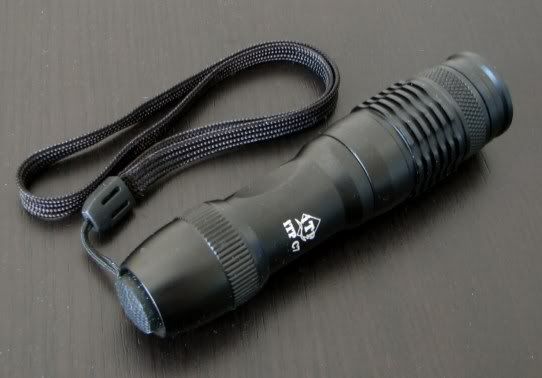
The quality of the wrist lanyard has improved on the shipping versions.
Comparison of the tailcaps - Regular on the left, Tactical on the right.
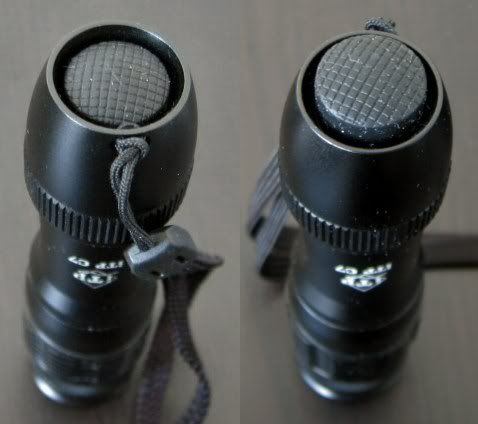
The C7 and C8 share the same tailcap and head - much like the Fenix LD10/LD20 or L1D/L2D. The common head features mild heatsinking fins near the base and rounded front edges near the glass lens. The C7 tailcap is more rounded than most lights in this class.
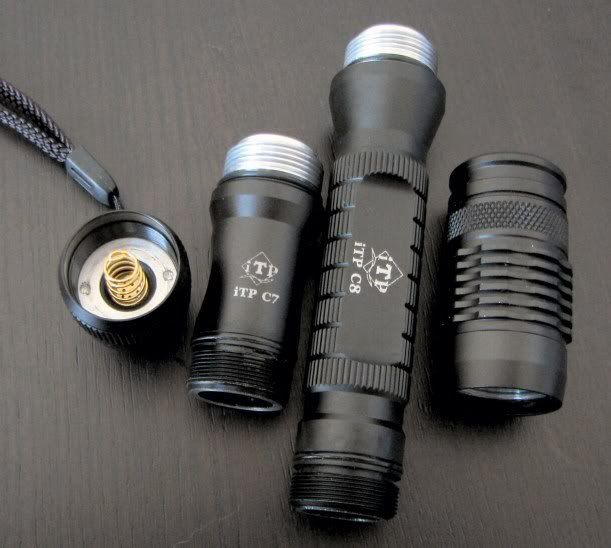
The only visible build differences between the Regular and Tactical versions are are in terms of the tailcap - the Regular features a standard reverse clicky and can tailstand, while the Tactical has a protruding forward clicky that can't. Note that the 1xCR123A C9 has a distinct one-piece body/tailcap design that doesn't use a separate tailcap (i.e. similar to the NiteCore Extreme).
Quality of the screw threads is very high. For the head portion of the body, ITP is using square flat-top thread (similar to JetBeam, although not quite as thick). Thread action is very smooth on all my ITP lights. :twothumbs: This is important, since ramp activation is controlled by loosening the head (again, scroll down for UI discussion). The tailcap has thinner anodized threads that allow for tailcap lockout. :thumbsup:
Fit and finish of the type III hard anodizing is very good on all samples - very even, with no discolorations or issues. Logo lettering is not as sharp on the pre-production body tubes as the final shipping versions, so keep that in mind as you look over the pics.
One of my protected AW 14500s was a tight fit in the pre-production C7 body tube, but all fit fine on my shipping C7T sample. All my NiMH cells fit the C7/C8 bodies fine.
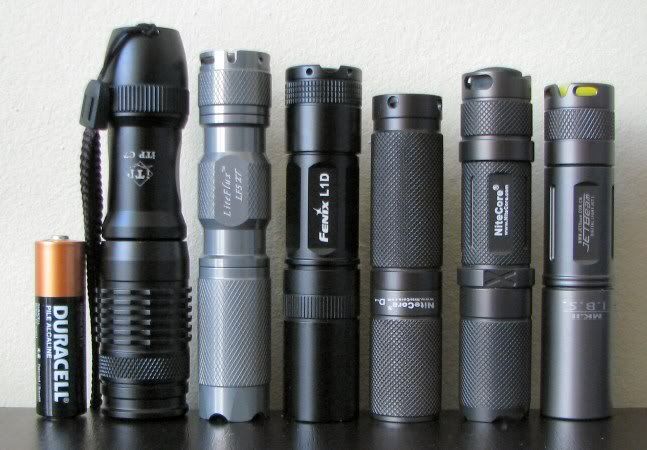
From left to right: the ITP C7 Regular, LiteFlux LF5XT, Fenix L1D, NiteCore D10, NiteCore Defender Infinity, JetBeam Jet-I MK IBS.
Features and User Interface
All ITP lights share a common a continuously-variable output mechanism with memory. The Regular version (which comes with a reverse clicky) features an extra strobe and SOS mode, and the Tactical version (which comes with a protruding forward clicky) lacks the strobe/SOS modes. On Regular models, you switch between states (constant-on, strobe, SOS) by soft-pressing the clicky, or turning the light off/on with 5 secs. If you leave it off longer than 5 secs, the light will come back on at constant-on at whatever level you last memorized it at. I measured strobe at 9.5Hz on my sample. Forward clicky on the Tactical model is a straight-forward momentary on with soft press, click to lock-on.
The continuously-variable UI is remarkably straight-forward: to activate the ramp, simply loosen the head slightly. This immediately starts the output ramping. When the light reaches the level you like, simply tighten the head to memorize that setting. To reverse the direction of the ramp, tighten and loosen the head again.
Note that unlike the continuously-variable competition, this UI doesn't require any special manual dexterity (i.e. you don't need to perform a rapid twist switch or click repeatedly within a narrow time-window). Just loosen the head to ramp, tighten to save the setting. Very simple and intuitive.
Turn the light on/off by the tailcap clicky. The light always comes back on at whatever level it was previously set to. Memory is retained even if you remove the battery. The light will flash rapidly 3 times when it reaches the min or max of its ramp.
I believe ITP uses PWM in these lights ("constant-current" is how they describe it) - but the freq is high enough so that I can't detect it by eye or instrument. :thumbsup:
Comparison Beamshots
All lights are on Sanyo Eneloop, on Max, and are ~0.5 meters from a white wall.
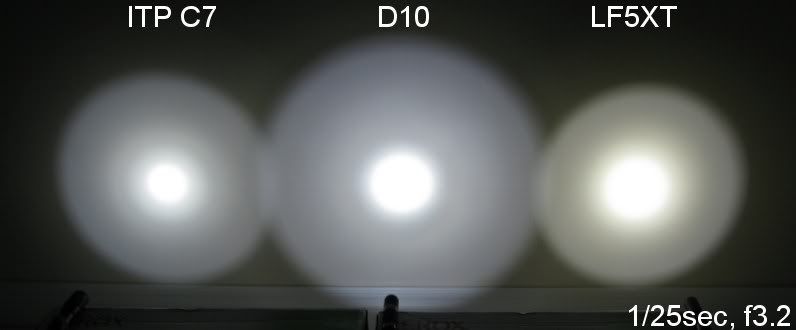
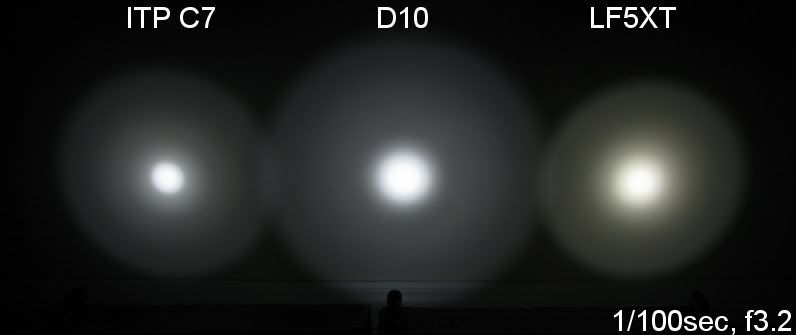
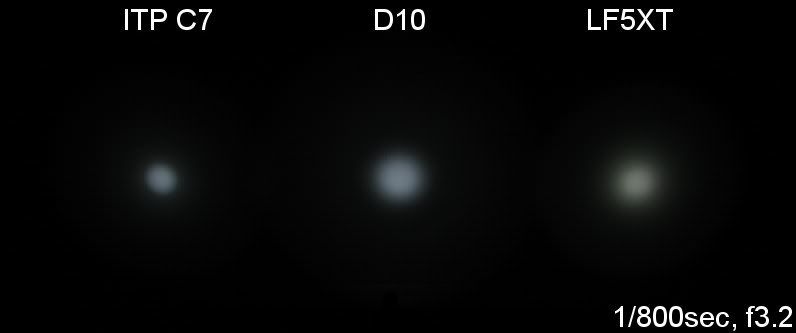
The ITP C7 beam profile is identical to the Olights with the same partially textured reflector (not shown). This produces a nicely defined center hotspot with relatively few rings. Overall spillbeam width is narrower than most lights, due to the relatively deep reflector - similar the LiteFlux LF5XT. Tint is a premium white on all my ITP samples.
Testing Method: All my output numbers are relative for my home-made light box setup, a la Quickbeam's flashlightreviews.com method. You can directly compare all my relative output values from different reviews - i.e. an output value of "10" in one graph is the same as "10" in another. All runtimes are done under a cooling fan, except for the extended run Lo/Min modes which are done without cooling.
Throw values are the square-root of lux measurements taken at 1 meter from the lens, using a light meter.
Throw/Output Summary Chart:
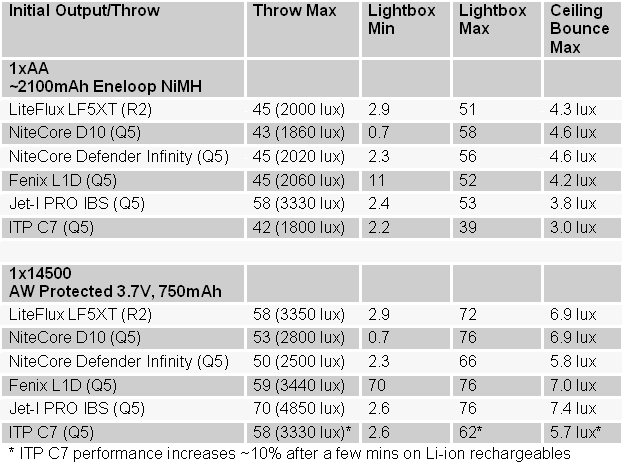
Note that I haven't included the C7T results in the table yet - while Throw is unchanged, Overall Output is increased on standard batteries compared to the pre-production Regular version (see runtimes below for comparison). Throw is generally intermediate to the other lights here - it's not a huge thrower, but it typically throws more than most.
Variable Output Ramping
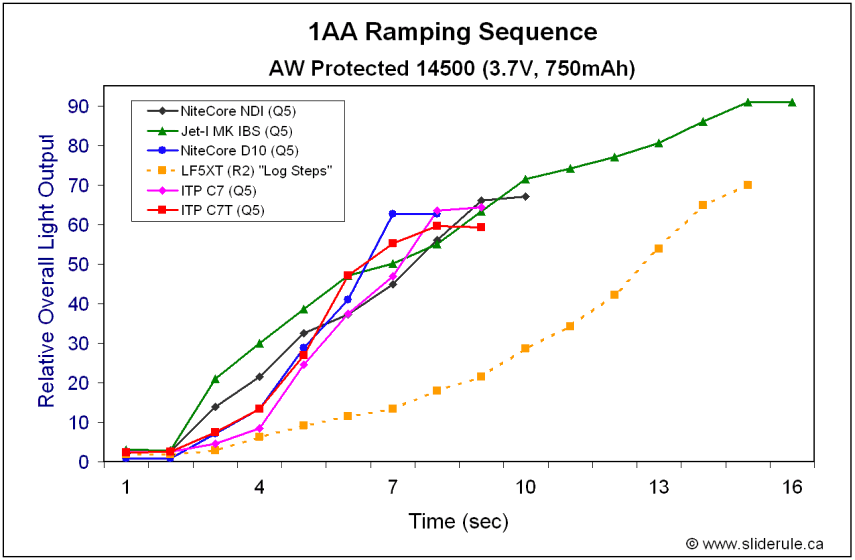
As you can see, the C7 ramp is relatively linear and faster than most of the competition. In fact, it is virtually identical to the NiteCore D10 (with very similar min and max levels). The light flashes 3 times rapidly to let you know when it has reached the end of its ramp (either min or max).
Output/Runtime Comparison:
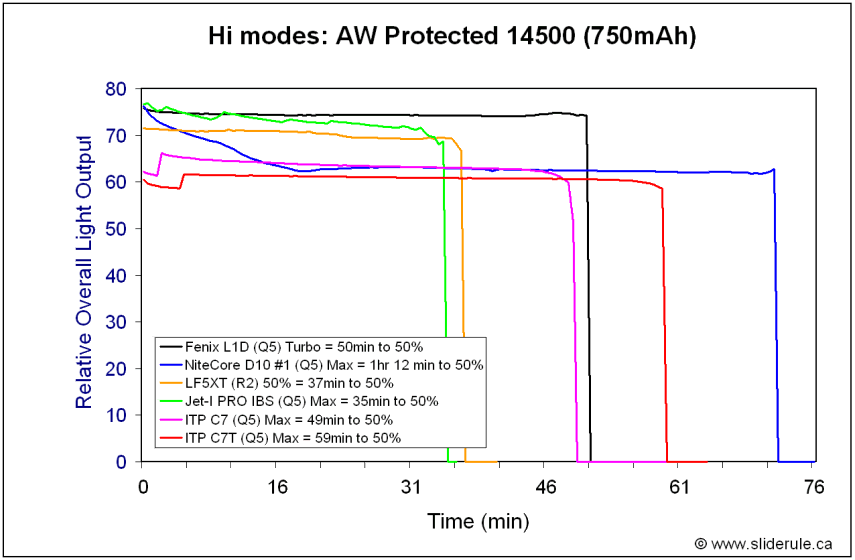
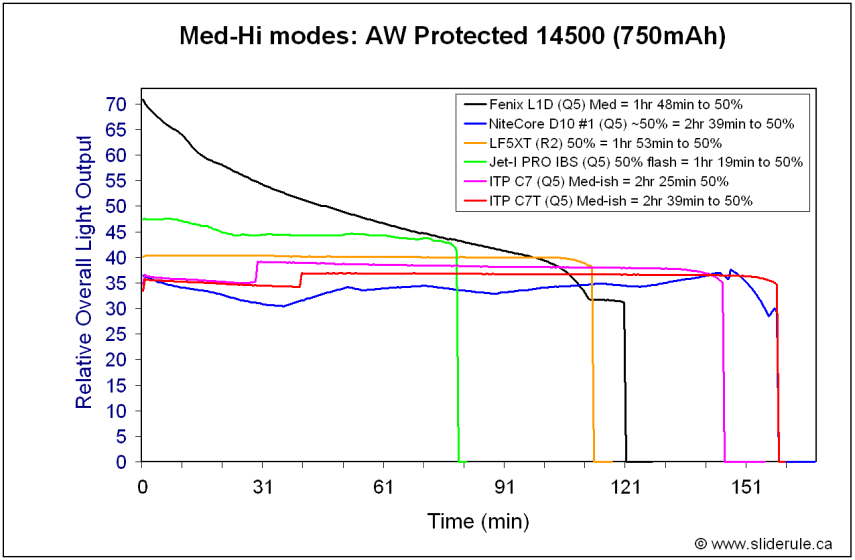
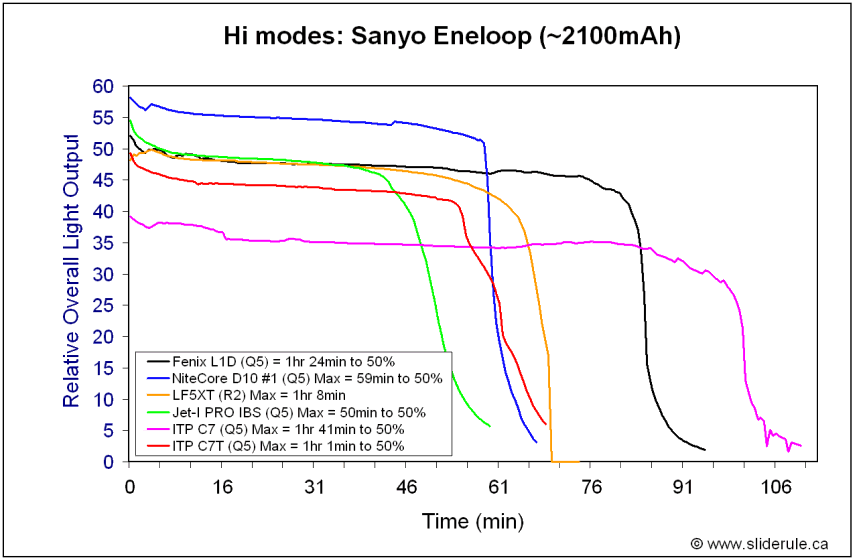
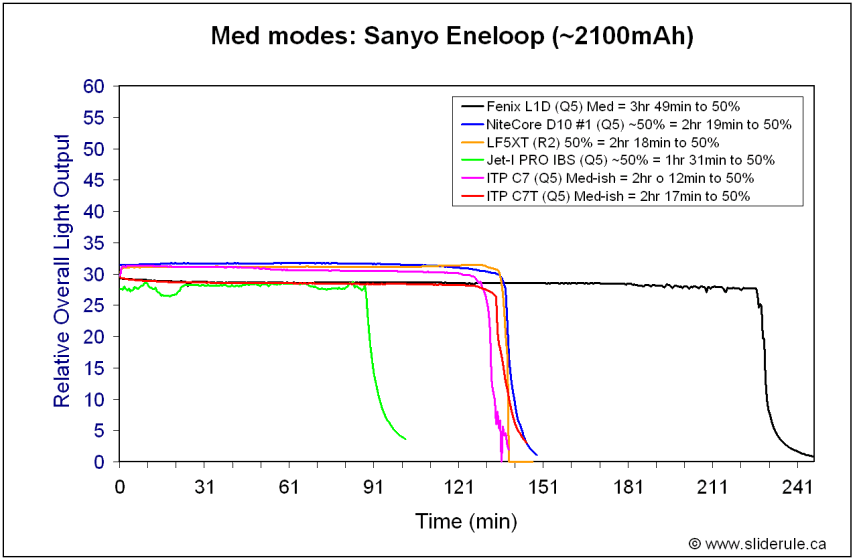
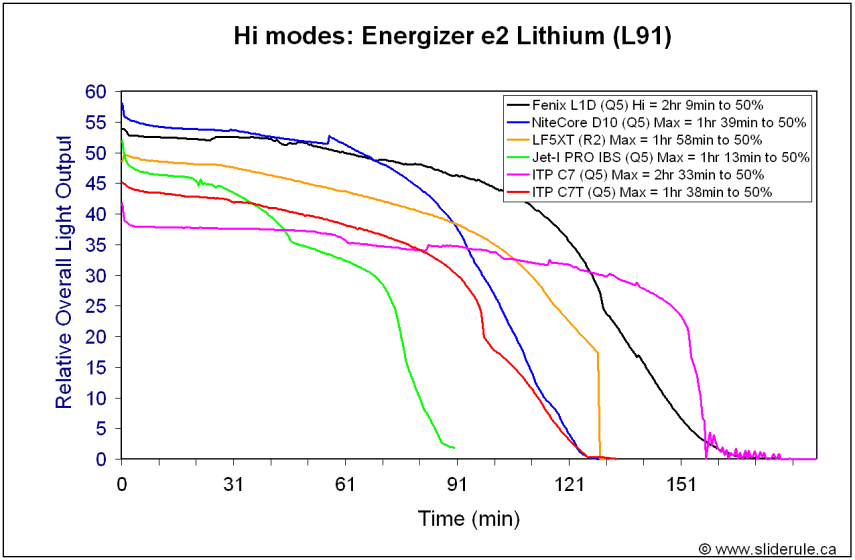
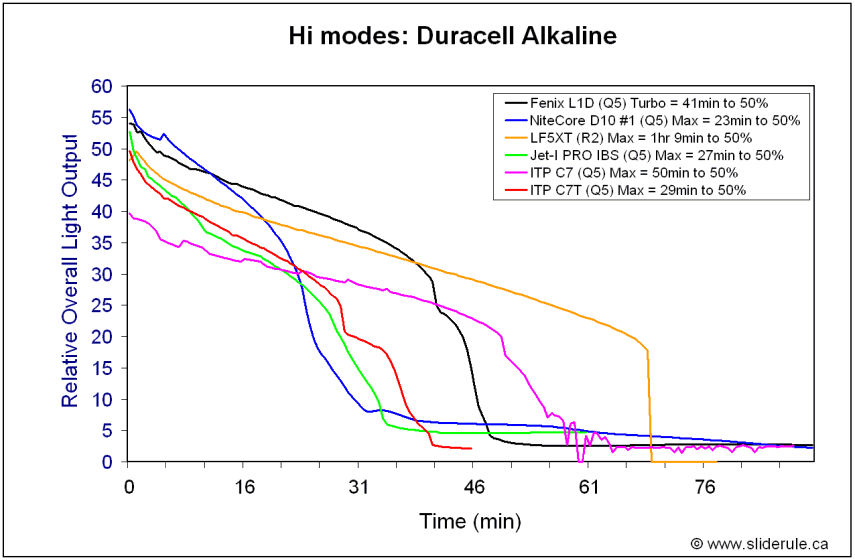
To more easily compare the pre-production Regular and shipping Tactical versions, here are a couple of simplified graphs:
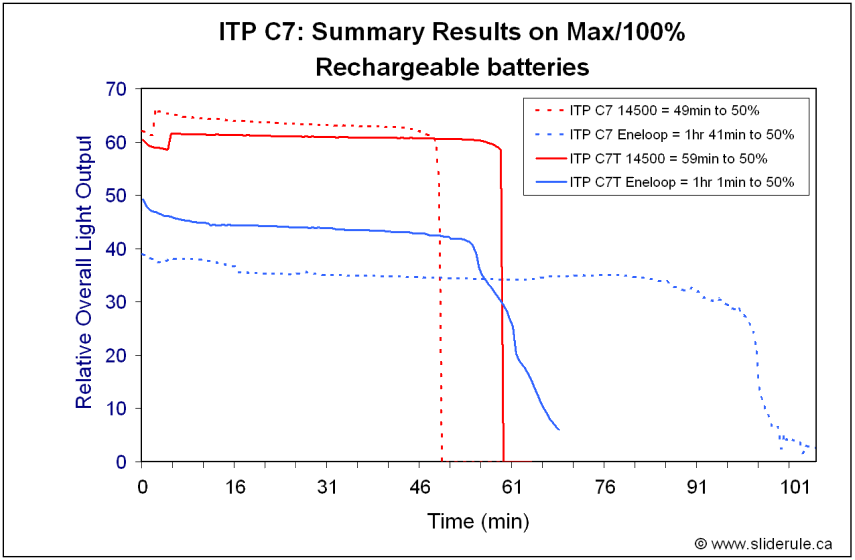
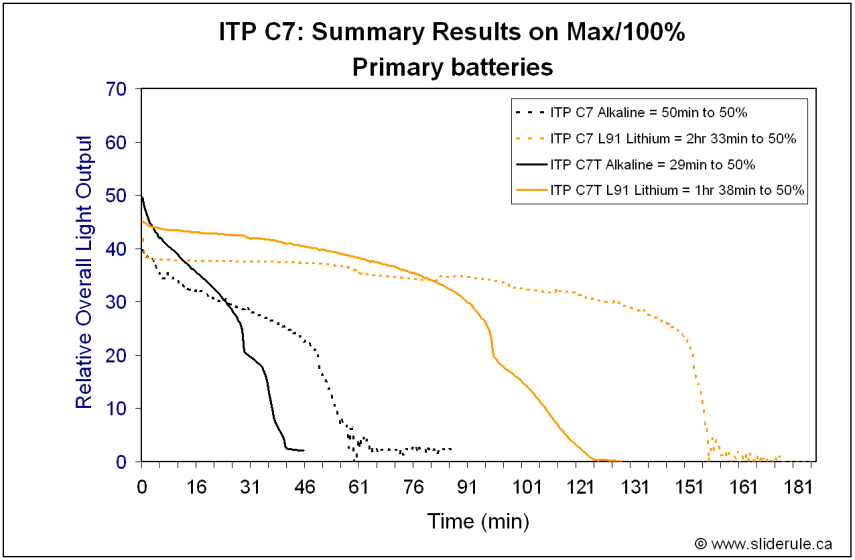
Output/Runtime Pattern of the C7:
First off, let me congratulate ITP on their decision to keep a common head for multiple battery configurations. The ability to perform battery tube "lego" is relatively uncommon in the flashlight world, and most welcome.
Build quality is very good, certainly on par with the competition. I would rate the overall build size and "heft" as similar to Olight, but with a more rounded appearance. The head threads are very smooth and solid, and the anodized tailcap threads allow for tailcap lock-out. :thumbsup:
The user interface is quite straight-forward and easy to use, with none of the potential problems of some continuously-variable lights that require rapid twisting or repeated clicking to switch states. I personally like the Tactical versions for their lack of strobe/SOS - but the Regular option is there for those who want it (and who favour tailstanding). All in all, this UI should be popular with those that favour a KISS approach. :kiss:
As for performance, ITP has managed one of the most linear regulation patterns I've seen on Li-ion, with output and runtime at least as good as the competition. Max output on 1xAA standard batteries (alkaline/NiMH) was a bit lower on the pre-production Regular light, but overall output/runtime efficiency remained consistently decent at all levels on all lights.
I'm glad to see ITP is listening to the feedback of the CPF community (i.e. removing the superfluous low voltage flash, offering individual body tubes at low cost, etc.). The low cost of these lights - and the additional body tubes - makes ITP a serious contender in this space. It bodes well in terms of ongoing consumer choice in the continuously-variable flashlight segment.
Warning: Pic heavy!

The C7 is part of a series of new continuously-variable lights from ITP. The lights come with either a Tactical or Regular head that is interchangeable on three different battery/body tube configurations: 1xAA/14500 (C7), 2xAA (C8), and 1xCR123A/RCR (C9). The pre-production C9 Regular model was reviewed previously, and the shipping C8 Regular and Tactical versions have just been reviewed as well.
Note that ITP has made individual body tubes/tailcaps available for sale, so you can mix-and-match components for different battery configurations with your preferred head unit (the Tactical and Regular versions differ slightly in circuit programming in the head).
For those of you not familiar with ITP lights, they have one of the most intuitive and easy-to-use continuously-variable systems I've seen to date. Scroll down for a discussion of the user interface.

The shipping versions of the C7s come in a standard cardboard box (identified as Tactical or Regular on the top). Included inside are the light, an attached wrist strap, instruction manual, warranty card, and a package of spare o-rings and an extra tailcap switch cover.
C7 Weight: 76.2 g
C7 Length: 107 mm (Regular), 110 mm (Tactical)
C7 Width: 27 mm max (at heatsink fins on the head)

Note the aluminum reflector - it's half textured and half smooth, similar to early Olights.
Here are some pics of the Regular version, with the pre-production C7 body and tailcap:


And here is the new Tactical version with the shipping C7 body and tailcap:


The quality of the wrist lanyard has improved on the shipping versions.
Comparison of the tailcaps - Regular on the left, Tactical on the right.

The C7 and C8 share the same tailcap and head - much like the Fenix LD10/LD20 or L1D/L2D. The common head features mild heatsinking fins near the base and rounded front edges near the glass lens. The C7 tailcap is more rounded than most lights in this class.

The only visible build differences between the Regular and Tactical versions are are in terms of the tailcap - the Regular features a standard reverse clicky and can tailstand, while the Tactical has a protruding forward clicky that can't. Note that the 1xCR123A C9 has a distinct one-piece body/tailcap design that doesn't use a separate tailcap (i.e. similar to the NiteCore Extreme).
Quality of the screw threads is very high. For the head portion of the body, ITP is using square flat-top thread (similar to JetBeam, although not quite as thick). Thread action is very smooth on all my ITP lights. :twothumbs: This is important, since ramp activation is controlled by loosening the head (again, scroll down for UI discussion). The tailcap has thinner anodized threads that allow for tailcap lockout. :thumbsup:
Fit and finish of the type III hard anodizing is very good on all samples - very even, with no discolorations or issues. Logo lettering is not as sharp on the pre-production body tubes as the final shipping versions, so keep that in mind as you look over the pics.
One of my protected AW 14500s was a tight fit in the pre-production C7 body tube, but all fit fine on my shipping C7T sample. All my NiMH cells fit the C7/C8 bodies fine.

From left to right: the ITP C7 Regular, LiteFlux LF5XT, Fenix L1D, NiteCore D10, NiteCore Defender Infinity, JetBeam Jet-I MK IBS.
Features and User Interface
All ITP lights share a common a continuously-variable output mechanism with memory. The Regular version (which comes with a reverse clicky) features an extra strobe and SOS mode, and the Tactical version (which comes with a protruding forward clicky) lacks the strobe/SOS modes. On Regular models, you switch between states (constant-on, strobe, SOS) by soft-pressing the clicky, or turning the light off/on with 5 secs. If you leave it off longer than 5 secs, the light will come back on at constant-on at whatever level you last memorized it at. I measured strobe at 9.5Hz on my sample. Forward clicky on the Tactical model is a straight-forward momentary on with soft press, click to lock-on.
The continuously-variable UI is remarkably straight-forward: to activate the ramp, simply loosen the head slightly. This immediately starts the output ramping. When the light reaches the level you like, simply tighten the head to memorize that setting. To reverse the direction of the ramp, tighten and loosen the head again.
Note that unlike the continuously-variable competition, this UI doesn't require any special manual dexterity (i.e. you don't need to perform a rapid twist switch or click repeatedly within a narrow time-window). Just loosen the head to ramp, tighten to save the setting. Very simple and intuitive.
Turn the light on/off by the tailcap clicky. The light always comes back on at whatever level it was previously set to. Memory is retained even if you remove the battery. The light will flash rapidly 3 times when it reaches the min or max of its ramp.
I believe ITP uses PWM in these lights ("constant-current" is how they describe it) - but the freq is high enough so that I can't detect it by eye or instrument. :thumbsup:
Comparison Beamshots
All lights are on Sanyo Eneloop, on Max, and are ~0.5 meters from a white wall.



The ITP C7 beam profile is identical to the Olights with the same partially textured reflector (not shown). This produces a nicely defined center hotspot with relatively few rings. Overall spillbeam width is narrower than most lights, due to the relatively deep reflector - similar the LiteFlux LF5XT. Tint is a premium white on all my ITP samples.
Testing Method: All my output numbers are relative for my home-made light box setup, a la Quickbeam's flashlightreviews.com method. You can directly compare all my relative output values from different reviews - i.e. an output value of "10" in one graph is the same as "10" in another. All runtimes are done under a cooling fan, except for the extended run Lo/Min modes which are done without cooling.
Throw values are the square-root of lux measurements taken at 1 meter from the lens, using a light meter.
Throw/Output Summary Chart:

Note that I haven't included the C7T results in the table yet - while Throw is unchanged, Overall Output is increased on standard batteries compared to the pre-production Regular version (see runtimes below for comparison). Throw is generally intermediate to the other lights here - it's not a huge thrower, but it typically throws more than most.
Variable Output Ramping

As you can see, the C7 ramp is relatively linear and faster than most of the competition. In fact, it is virtually identical to the NiteCore D10 (with very similar min and max levels). The light flashes 3 times rapidly to let you know when it has reached the end of its ramp (either min or max).
Output/Runtime Comparison:






To more easily compare the pre-production Regular and shipping Tactical versions, here are a couple of simplified graphs:


Output/Runtime Pattern of the C7:
- Overall, no major surprises - output/runtime performance of the C7/C8 is pretty consistent, with no obvious drops in efficiency at any output level tested.
- On Li-ion (14500), overall output and runtime performance of the C7 is very consistent with the competition.
- On standard batteries (alkaline, NiMH, and including L91 lithiums), max output of the pre-production Regular C7 is lower than most of the other lights tested here. However, runtime is typically better, consistent with the lower output.
- As noted in my C9 review, regulation on Li-ions is remarkably linear - among the best I've seen (the only quirk is a single quick jump in output of ~10% early in the runs)
- The pre-production Regular C7 featured a low voltage warning flash on all battery types, that kicked in once the light was out of regulation. ITP has removed this on shipping versions of both the Regular and Tactical lights, since it was largely superfluous.
First off, let me congratulate ITP on their decision to keep a common head for multiple battery configurations. The ability to perform battery tube "lego" is relatively uncommon in the flashlight world, and most welcome.
Build quality is very good, certainly on par with the competition. I would rate the overall build size and "heft" as similar to Olight, but with a more rounded appearance. The head threads are very smooth and solid, and the anodized tailcap threads allow for tailcap lock-out. :thumbsup:
The user interface is quite straight-forward and easy to use, with none of the potential problems of some continuously-variable lights that require rapid twisting or repeated clicking to switch states. I personally like the Tactical versions for their lack of strobe/SOS - but the Regular option is there for those who want it (and who favour tailstanding). All in all, this UI should be popular with those that favour a KISS approach. :kiss:
As for performance, ITP has managed one of the most linear regulation patterns I've seen on Li-ion, with output and runtime at least as good as the competition. Max output on 1xAA standard batteries (alkaline/NiMH) was a bit lower on the pre-production Regular light, but overall output/runtime efficiency remained consistently decent at all levels on all lights.
I'm glad to see ITP is listening to the feedback of the CPF community (i.e. removing the superfluous low voltage flash, offering individual body tubes at low cost, etc.). The low cost of these lights - and the additional body tubes - makes ITP a serious contender in this space. It bodes well in terms of ongoing consumer choice in the continuously-variable flashlight segment.
Last edited:



